Export contacts from Outlook
When you export your contacts from Outlook, a copy of your contacts is saved to a CSV file, or other file type. You can then use this file to import your contacts to another email account.
-
In Outlook 2013 or 2016 on a PC, choose File.
If your ribbon doesn't have a File option in the top left corner, you're not using Outlook 2016 or 2013. See What version of Outlook do I have? to get to the export instructions for your version of Outlook.

-
Choose Open & Export > Import/Export.
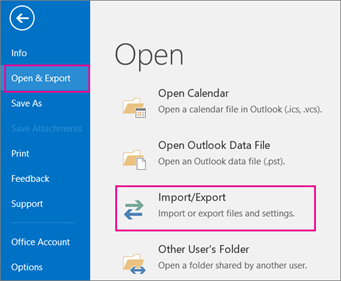
-
Choose Export to a file.
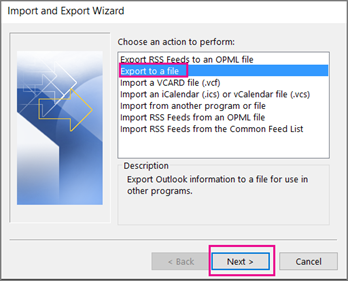
-
Choose Comma Separated Values.
-
THIS STEP IS KEY especially if you're borrowing a friend's computer: In the Select folder to export from box, scroll to the top if needed and select the Contacts folder that's under your account. Choose Next.
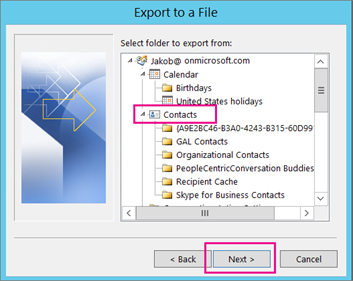
-
Choose Browse, name your file, and choose OK.

-
Confirm where your new contacts file will be saved on your computer, and choose Next.
-
Choose Finish to start exporting your contacts immediately. Outlook doesn't display any message when the export process is complete but the Import and Export Progress box goes away.
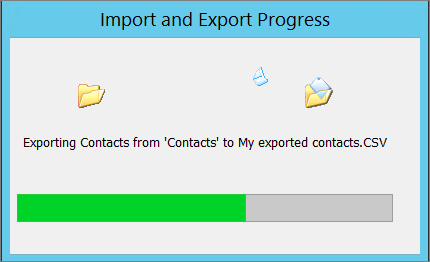
-
Locate the new .csv file on your computer and open it with Excel to verify your contacts are there. You'll likely have a lot of empty cells. That's normal.

-
Generally we recommend closing the file without saving any changes; otherwise the file might get messed up and you won't be able to use it for importing. If that happens you can always run the export process again and create a new file.
You can use Excel to update the information in your .csv file. For tips about working with a list of contacts in Excel, see Create or edit .csv files.
-
If you borrowed a friend's computer with Outlook on it, you can now remove your account from his version of Outlook. Here's how:
-
In Outlook on the desktop, choose File > Account Settings > Account Settings.
-
Choose the account you want to delete, and then choose Remove.
-
Choose Close.
-
-
Now that your contacts are copied to a .csv file, you can import them to another computer with Outlook for Windows on it, or import them to another email service.
If you have an Office 365 mailbox, you can access it over the Internet, just like you sign in to Facebook, Gmail, or Amazon. It looks like this:

To export your contacts from your Office 365 mailbox, you need to use the Outlook app, such as Outlook 2016, 2013, 2010, or 2007. When you launch the Outlook app, you'll see "File" in the top left corner:
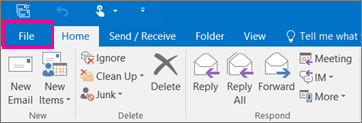
To export your Office 365 email contacts:
-
Add your Office 365 email account to the Outlook app.
The Outlook app will sync with your Office 365 mailbox. After a while, you'll see a copy of your email and contacts in the Outlook app.
-
Export a copy of your contacts from the Outlook app, using the instructions in this article for your version of Outlook.
If you don't have the Outlook app installed on your computer, see How to get Outlook.
-
At the top of your Outlook 2010 ribbon, choose the File tab.
If your ribbon doesn't have a File option in the top left corner, you're not using Outlook 2010. See What version of Outlook do I have? to get to the import instructions for your version of Outlook.

-
Choose Options.
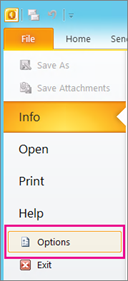
-
In the Outlook Options box, choose Advanced.
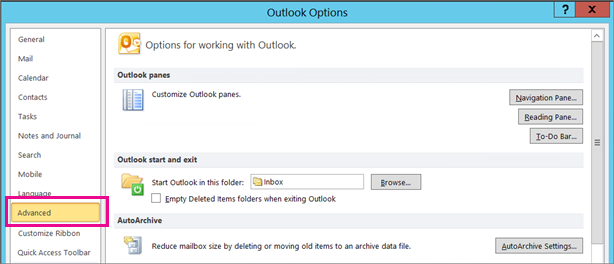
-
Under the Export section, choose Export.

-
In the Import and Export Wizard, select Export to a file, and then choose Next.
-
Under Create a file of type, choose the type of export that you want. The most common is Comma Separated Values (Windows), also known as a .csv file. Then click Next.
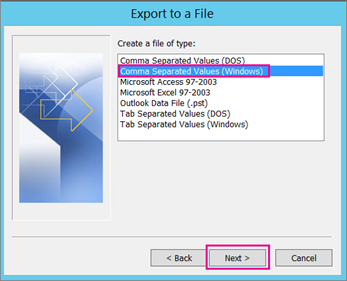
If you are exporting contacts for use in another copy of Outlook, choose an Outlook Data File (.pst).
-
Under Select folder to export from, you may need to scroll up, and then select the contact folder that you want to export. Choose Next when you're done.
Note: Unless you chose to export to an Outlook Data File (.pst), you can only export one folder at a time.
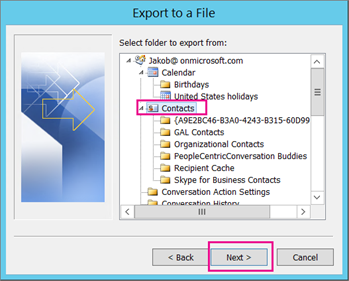
-
Under Save exported file as, click Browse, select a destination folder, and in the File name box, type a name for the file.

-
Click OK.
-
In the Export to a File dialog box, click Next.
-
Choose Finish to start exporting your contacts immediately. Outlook doesn't display any message when the export process is complete but the Import and Export Progress box goes away.

-
When the export is finished, choose OK to exit the Outlook Options box.
-
Go to the location on your computer where you saved your contacts, for example, in the Documents folder.
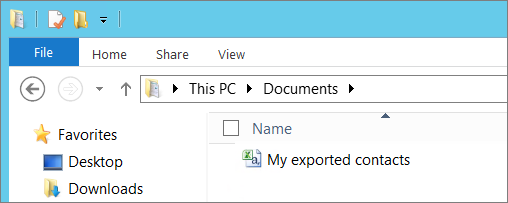
-
If you exported your contacts as a .csv file, you can use Excel to see what was exported from Outlook. You'll likely have a lot of empty cells. That's normal.

-
Generally we recommend closing the file without saving any changes; otherwise the file might get messed up and you won't be able to use it for importing. If that happens you can always run the export process again and create a new file.
You can use Excel to update the information in your .csv file. For tips about working with a list of contacts in Excel, see Create or edit .csv files.
To import your contacts into Outlook 2016, see Import contacts to Outlook.
-
In Outlook 2007, at the top of your ribbon choose File.
If your ribbon doesn't have a File option in the top left corner, you're not using Outlook 2007. See What version of Outlook do I have? to get to the import instructions for your version of Outlook.
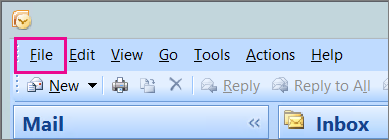
-
Choose Import and Export.
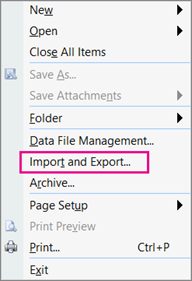
-
Select Export to a file, and then click Next.
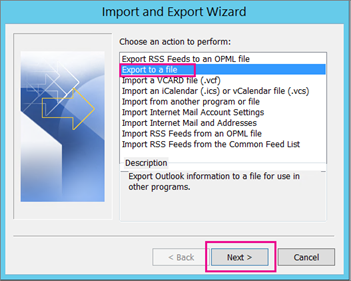
-
Choose Comma Separated Value, and then click Next.
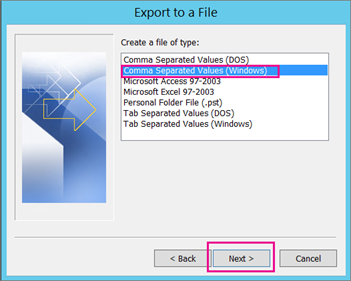
-
In the folder list, scroll up if needed and choose the contacts folder you want to export, and then click Next.
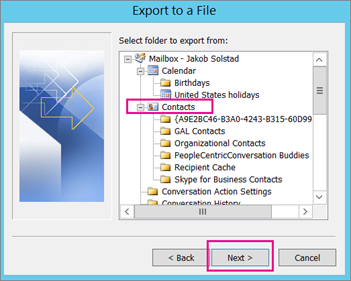
-
Choose Browse, type a name for the exported file, and then click OK.

-
Click Next.
-
Choose Finish to start exporting your contacts immediately. Outlook doesn't display any message when the export process is complete but the Import and Export Progress box goes away.

-
If you exported your contacts as a .csv file, you can use Excel to see what was exported from Outlook. You'll likely have a lot of empty cells. That's normal.

-
Generally we recommend closing the file without saving any changes; otherwise the file might get messed up and you won't be able to use it for importing. If that happens you can always run the export process again and create a new file.
You can use Excel to update the information in your .csv file. For tips about working with a list of contacts in Excel, see Create or edit .csv files.
No comments:
Post a Comment